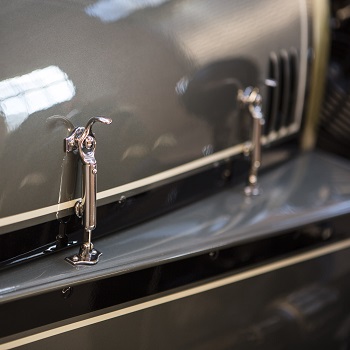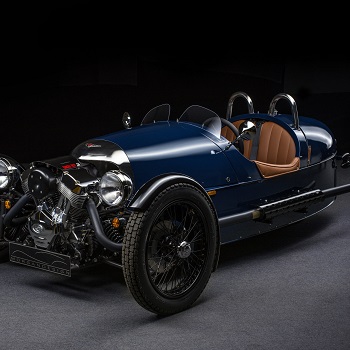
Morgan
When did you last regard a journey by motor car as an adventure? The Morgan 3 Wheeler is designed to bring the fun and passion back to personal transport. Lift the safety catch from the 'bomb release' starter button, hear the massive twin cylinders detonate and choose your favorite destination.
The iconic design of the Morgan Threewheeler has been updated with 21st Century technology. The power train is a 1983cc 'V-twin' fuel injected engine mated to a Mazda 5 speed (and reverse) gearbox. This provides smooth 'get in and drive' convenience with the thrill of extreme performance.
SPECIFICATION
The Morgan 3 Wheeler is designed for one purpose alone, to make driving fun. A leather padded cockpit complete with aircraft instrumentation adds to the sense of flying on the road. The car seems to respond as much to thought as physical input. With an estimated 140 Newton meters of torque, the motor provides maximum power at minimum revs. When coupled with a weight of 525kgs the 21st century Morgan 3 Wheeler provides unrivaled power to weight for it's on the road price. The time is right for Morgan to take a new look at the combination of acceleration, performance, and economy. The time is right to drive a Morgan 3 Wheeler.
TECHNICAL
- Engine
- S&S 1983cc V twin
- Gearbox
- Mazda 5 Soeed
- Max Power (@5250rmp)
- 82 bhp
- Max Torque (@3250rpm)
- 140Nm
- Performance 0 - 62
- 6 seconds
- Top Speed
- 115mph ( 185 kph)
- Power to weight
- 435kw / kg
- Urban mpg
- Extra urban
- Extra urban
- 44.9 mpg (6.31 / 100km)
- Combined
- 30.3 mpg (9.3 / 100km)
- cO2
- 215 g/km
- Length
- 3225mm
- Width
- 1720mm
- Height
- 1000mm
- Dry weight
- 525kg
- Homologation
- EU + USA
- Fuel tank size
- 42 litres
- Chassis
- Tubular steel spaceframe
New Options For 2016
As with any Morgan, each 3 Wheeler can be specified to achieve a certain look. The level of personalization allows customers to create a more classically inspired vehicle or one with a few more modern additions and themes. A range of new heritage inspired options have been introduced to the 3 Wheeler range for 2016. All of these options have been hand-picked to allow owners the chance to create a new 3 Wheeler that is truly reminiscent of the originals.
Where it all began
The success of the Morgan Motor Company was founded on an icon, the Morgan Three-Wheeler. This brilliant but simple design by skilled engineer and company founder Harry Morgan (HFS) became one of the most successful lightweight cars of the early days of motoring. The principal of fitting a powerful motorcycle engine and simple transmission into a light-weight chassis and body inspired a new type of vehicle which generically became known as the 'Cyclecar'. Thus the fashion for 'new motoring' introduced the freedom of the open road to those of more modest means. The Morgan Runabout was at the forefront of this movement and therefore Harry Morgan can be regarded as the man who first introduced motoring for the masses.
Setting the standard
Built at the original Morgan factory, Malvern Link, not only was the Morgan one of the first Cyclecars, it was, without doubt, the best engineered, the most reliable, and the most successful vehicle in its class which set the standards for other manufacturers to follow. It featured a simple two speed transmission (fast and very fast), but no reverse gear (to go backwards required gravity, or the driver had to get out and push). Engines were usually J.A.P. V-twins, although the simplicity of the chassis design allowed many other makes to be fitted.
Racing success
Within a few weeks of its launch at the Olympia motorcycle show in London in November 1910, Harry Morgan entered the Runabout in the MCC London to Exeter Trial, and his remarkable performance won a Gold Medal. This was the first of many such victories in all forms of motorsport such as reliability trials, plus racing and record-breaking particularly at the Brooklands autodrome.
In little more than three years, by the outbreak of World War 1 in 1914, Morgans had secured 10 British and World Records for various classes of cyclecars, won 24 Gold Medals in major reliability trials and had achieved numerous victories on the race track. These successes included an astonishing drive by Mr. Harry Martin who easily won the first International Cyclecar Race at Brooklands, finishing over two minutes ahead of the second place car even though Martin had completed the race in just 8 and a half minutes! A few months later Harry Morgan won the Cyclecar Cup for the 1100 c.c. one-hour record, travelling at a fraction short of 60 m.p.h. for one hour at Brooklands.
The Cyclecar Grand Prix
The most significant victory of the early years was that of W.G. McMinnies in the International Cyclecar Grand Prix at Amiens in France. McMinnies and his passenger Frank Thomas won against strong opposition from many continental four-wheelers... All of this achieved in spite of an enforced stop to change an inner tube in one of the front tires! W.G. McMinnies was the editor of the "Cyclecar" magazine and his success gave Morgan a great deal of publicity. After the event he christened his particular car "Jabberwock of Picardy", and a new model, called the Grand Prix and based on the race winning car was introduced to the Morgan range.
The aero was born
Alas, Capt. Ball was shot down and killed shortly after taking delivery of his car, however, his special Morgan inspired the introduction, in 1920, of the next new sporting model which was called the Aero, in recognition of the famous aviator.
So advanced had been H.F.S. Morgan's first designs that little alteration, apart from bodywork modifications, were required for some years. The car retained its sturdy, lightweight construction and the two-speed transmission system remained in production for many years. A Family Runabout was introduced with four seats, to offer inexpensive motoring for the whole family.
























